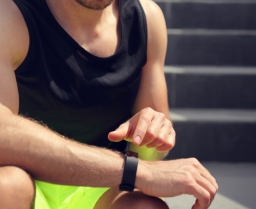Fitness Trackers and Counting Steps: Marketing Ploy or Health Tool?
Wednesday, August 9, 2017 - 09:07

Fitness trackers have become increasingly popular among both people who are new to exercise, and those who have been long-time athletes. Current wrist-worn trackers can function as watches, heart rate monitors, sleep trackers, calorie counters, GPSs, and even as phones, opening up a market that seems inconceivably far from the original pedometer. However, the 10, 000-step goal often encouraged by manufacturers does not have a scientific founding and recent research suggests that these trackers lack accuracy in certain measurements.
The Problem with Counting Steps
Most popular fitness trackers have a step counter as their predominant feature, displaying how close users are to their goal on the screen or its lights, vibrating in celebration when users have hit the magic number. Despite the popularity of the 10, 000 steps per day doctrine, the majority of national and international health authorities don’t prescribe a daily step recommendation – in Canada, for example, adults should aim to get 150 minutes of moderate-to-vigorous physical activity a week. The whole concept of the 10, 000 step goal and counting steps to measure fitness or physical activity could be flawed for several reasons:
- 10, 000 steps per day is a common number targeted by fitness tracker wearers and encouraged by manufacturers, but not because it marks some sort of threshold of health.
- 10, 000 is an arbitrary number that originated in the Japan in the 1960s, when a pedometer manufacturer nicknamed it manopo-kei (“10, 000 step meter”) and the business slogan caught on.
- The intensity of the steps matter.
- Taking 10, 000 meandering steps is very different from taking faster-paced steps – the ones that elicit cardiovascular benefits.
- Step counting doesn’t account for exercise not quantifiable in steps.
- Weight training, kickboxing, swimming, and cycling are among activities that can’t be measured by steps: it’s possible to be very physically active without reaching 10, 000 steps.
- Using an arbitrary number can turn a physical activity goal into a limit.
- People often stop, or think it’s enough to have hit 10, 000 steps, even if there was no sweating or heart-pumping activity in reaching it. More activity is almost always better, and people should not limit themselves to 10, 000.
Heart Rate and Calorie Measurement Accuracy
If not for the step-counter, users may use a fitness tracker as a heart rate monitor. Others use the calories burned feature when trying to lose weight. A study published in late May, 2017 compared the accuracy of seven different wrist-worn fitness trackers. They measured heart rate and energy expenditure (calories burned) of subjects when walking, running, and cycling and compared it to gold standard measurements.
- Most devices reported heart rate within an acceptable error range: <5% on a stationary bike, and <9% when walking
- There were higher error rates among participants with darker skin tones, larger wrist circumferences, and/or higher BMIs.
- None of the devices were accurate in measuring energy expenditure: error rates ranged from 27-93%
- Unlike directly measuring heart rate, each tracker must use its own algorithm to calculate energy expenditure. It’s hard to expect an algorithm to accurately take into account each individual’s unique fitness level, weight, height, etc.
- Many devices overestimated calorie expenditure, and if people are basing dietary decisions on those numbers, it can hinder weight loss progress or lead to unintentional weight gain. Instead, the focus should simply be on eating what we know are healthy foods.
Is There a Way to Use Fitness Trackers Positively?
Despite it all, fitness trackers can still be helpful tools to get active, particularly for people new to exercise. For some, making challenging step goals can be motivating to get more movement into their day. It’s important to keep in mind that step counts alone aren’t an accurate representation of your entire physical activity picture. They can provide a general idea of how much you’ve been moving, but reaching your step count goal or not does not determine how active your day has been, nor the quality of your exercise. Ideally, after getting into the groove of regularly getting active, incorporating a variety of activities will make for a well-rounded, healthy lifestyle.
Sources:
Dusheck J. (24 May 2017). Fitness trackers accurately measure heart rate but not calories burned. Stanford Medicine.
Harris-Fry N. (23 Feb 2017). Why 10, 000 Steps a Day is an Excellent Target. Coach Magazine.
Is 10, 000 Steps a Day a Pointless Goal? (21 Feb 2017). BBCNewsbeat.
Neighmond P. (24 May 2017). Fitness Trackers: Good at Measuring Heart Rate, Not So Good at Measuring Calories. NPR.
Rettner R. (24 May 2017) How Accurate Is Your Fitness Tracker, Really? Live Science.
Shcherbina A, Mattsson CM, Waggott D, Salisbury H, Christle JW, Hastie T, Wheeler MT, Ashley EA. Accuracy in wrist-worn, sensor-based measurements of heart rate and energy expenditure in a diverse cohort. Journal of Personalized Medicine. 2017; 7(2).
Stackpool CM, Porcari JP, Mikat R, Gillette C, Foster C. (January, 2015). Are Activity Trackers Accurate? ACE PROSource.
Tudor-Locke C, Hatano Y, Pangrazi RP, Kang M. Revisiting “how many steps are enough?”. Medicine & Science in Sports & Exercise. 2008; 40(7): 537-543.
Vanderloo L. (18 April 2017) What Science Actually Says About Taking 10, 000 Steps a Day. Huffington Post.
About the Author: Lily is a fourth-year student in the kinesiology program at Western University, currently interning with SIRC. With a background in synchronized swimming, she continues to be actively involved in sport as a coach and varsity athlete.